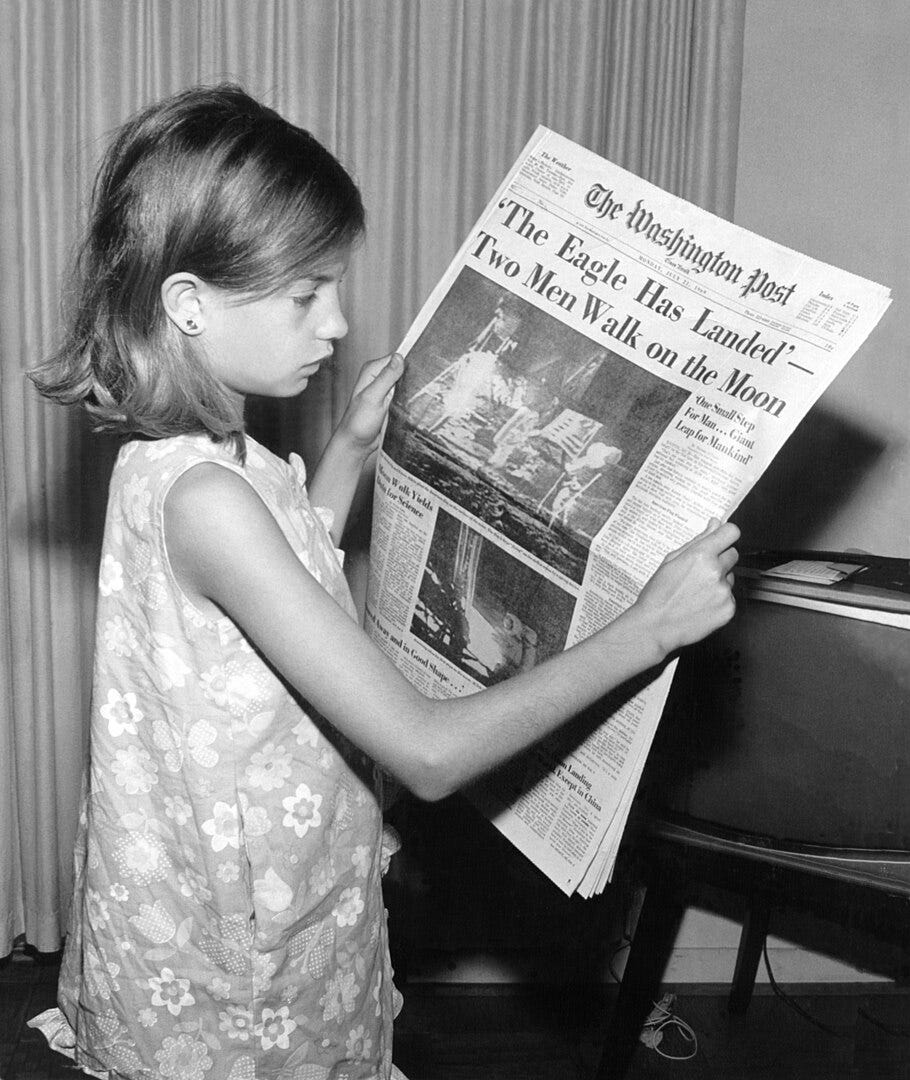
Few things are more depressing than seeing the American people grow dumber and dumber about our world. On the national level, there are still plenty of quality options available if you want to be informed. My personal favorite for down-the middle news coverage is the Wall Street Journal. But at $36.99 per month (after a discounted trial), it’s hardly cheap.
The problem is that a growing percentage of news consumers live in siloed media environments that pander to confirmation biases left, right and beyond. When those views are amplified on social media, where algorithms governing personal news feeds are tailored to such partisanship, the effect is that some folks become radicalized.
But the loss of news media outlets on the local level has been devastating, and has far exceeded any decline in national and international coverage. According to the Poynter Institute, a journalism think tank, since 2005, the U.S. has lost nearly 2,900 newspapers and 43,000 journalists, with 130 papers closing last year alone. With a relative handful of exceptions, those that remain are shells of their former selves.
The culprit, of course, is the catastrophic loss of classified advertising to CraigsList and others, along with the scarcity of display ads from real estate and auto dealerships who increasingly use their own websites to advertise, bolstered by rankings on Google and social media. Newspapers were also slow to embrace paywalls on their websites at the outset of the digital age some 25 years ago — a bad decision that conditioned audiences to believe expensive-to-produce content on the internet should be free.
Some larger papers such as the Washington Post, the Los Angeles Times and the Boston Globe have been acquired by wealthy people who are concerned about the possible disappearance of those publications and are willing to accept lower profits. Even so, as employees of these papers may have noticed and as the New York Times recently reported (free link), there are limits even to the largesse of the super rich.

In more densely populated areas, digital news platforms have tried to take the places of the departed newspapers. Those new ventures have met with some success in large-to-midsize metropolitan areas. Other existing chain papers maintain their mastheads, but have closed their newsrooms and publish little local news, relying instead on wire copy and regional coverage from other papers in the chain. This latter phenomenon has spawned the term “ghost newspapers.” Why anyone would pay to read or advertise on such a publication I do not know.
Sill other small community papers have transitioned to nonprofit status. In my neck of the woods, the Lakeville Journal, the award-winning 127-year-old weekly where I spent nine years of my career, nearly went out of business during the pandemic and has since gone the nonprofit route. This is not a magic elixir, however. It does make the LJ eligible for certain grants and it allows donors a measure of tax deductibility, but the fact remains that the business model must be sustainable.
But as Poynter notes, “when communities in less affluent or less densely populated areas lose their local newspaper, they often do not get a replacement.” Communities without newspapers or other media coverage are known in the trade as “news deserts.” The threats these smaller communities face for lack of coverage are obvious to those of us in the business. To those outside the journalist bubble, the risks might not be so apparent. So here’s the problem:
Recent studies have shown that an absence of media coverage at all levels correlates with higher government spending and rising taxes. Perhaps worst of all, corruption increases through lack of oversight. To wit, look at what happened in Bell, California, where no one was watching the crooks 10 years ago in the city council who were paying themselves $700,000 a year and the city manager $1.5 million.
That story was finally broken by the Los Angeles Times, which is itself struggling under a rich owner and laid off 20% of its newsroom last week. But as media critic and LAT watcher Chris Bray noted in a Substack column this week, the paper appears to have strayed from its mission. Bray found that the Times has five reporters covering the entire criminal justice system in Los Angeles, a county of some 10 million people, but it has eight individual reporters covering the following beats:
“It became a social justice newsletter to the exclusion of showing up and consistently covering budgeting and policy stories in California communities,” Bray wrote.
Clearly, the LAT made a decision at some point to “go global,” presumably in an effort to be “inclusive.” Inclusivity is a good thing if its goal is to unite people and attract a wider audience and more advertising. But the offenses committed in Bell were “inclusive” crimes. Government thievery touches and infuriates every honest taxpayer. So, too, is all the other corruption in Southern California that goes unreported in the name of inclusion.
Beyond the exposure of government corruption, a dearth of local coverage means you have few reliable sources of information about your own community. How then are you supposed to make informed decisions about whom to vote for to run your town or city? Sure, you can watch recordings of your city council’s meetings or look at a rant from your down-the street neighbor on Facebook, but who has the time or patience to wade through it all? Journalists, including yours truly, aren’t perfect. Sometimes we screw up; sometimes we let our own views intrude on our coverage. We’re human beings, not robots. But to paraphrase Winston Churchill, journalism is the worst way to stay informed “except for all those other forms that have been tried from time to time.”
And it’s not just newspapers. The troubles for the media business extend to magazines and mass media companies. Earlier this month, Sports Illustrated basically gutted itself, while Paramount (formerly known as Viacom CBS) announced unspecified layoffs. For a comprehensive round-up, Axios has all you need to know.
It might be comforting for conservatives to take delight in the poetic justice of liberal journalists getting punished for their biases. But of course this is utter bullshit. By their logic, conservative papers should be doing just fine. But they too are suffering.
Here in Connecticut, newsroom staff at the Waterbury Republican-American, where I have many friends, is about half what it was 25 years ago and I’m told no one has had a raise in the last 13 years. The family that owns it is so right-wing that I can barely even look at the editorial page. They do not publish any op-eds that lean left, so it's mostly a steady diet of David Harsanyi, Betsy McCaughey, Michael Reagan and any other cheaply syndicated conservative opinion writer they grab.
The situation is much the same at the New Hampshire Union Leader. You may recall the UL’s longtime arch-conservative publisher, the late William Loeb, was the one who in 1972 made Democratic presidential candidate Ed Muskie cry on the steps of the capitol in Concord after running a story that depicted Mrs. Muskie as a drunkard, among other things (the crying part might have been apocryphal, as reported below):
Things have gotten so bad for the Union Leader that the company had to sell its own building to keep its head above water. Now I’m told many employees work remotely and the paper leases its remaining space to businesses and nonprofits.
Holding public officials accountable is essential to any democracy. Support your local media outlets, be they print newspapers, digital products or your regional public radio station. As Italian novelist and journalist Albert Moravia once observed, “Dictatorships are one-way streets. Democracy boasts two-way traffic.”






Right on, Mr. Cowgill! The decline of local newspapers is indeed a threat to democracy. Although I can see where you are coming from, I cannot bring myself to support the WSJ, for the simple reason that I would be supporting the Murdoch family enterprise.
When I was a lad we recieved the Hartford Courant and the Waterbury Republican every morning and the Winsted Evening Citizen every afternoon. The secret to the then success of the Evening Citizen (under the editorship of Ted Vail, who most people in town referred to as T. V.) seemed to be the section called “City News Notes “ which were brief snippets of local gossip about boy/girl scout events, anniversaries, college acceptances, notes that sons and daughters were returning home from another successful year at school, or a list of all the guests at someone’s Fourth Grade birthday party.
There were many people in town (including some of the Evening Citizen’s corporators) who, when the Winsted paper merged with the Torrington Register, predicted the eventual demise of the merged newspaper. History would seem to bear that out.
In its new weekly format, the Register Citizen has become a ghost newspaper, seeming to print stories from almost anywhere except Winsted or Torrington. Ralph Nader’s recent effort to revive the “Citizen “ brand may have been a valiant gesture, but…
The Hartford Courant has become a mere shadow of its former self. And the Waterbury Republican-American, well, I thought it was right-wing when I was in high school, oh, how little I knew.
I must say that I am impresseed, daring to paraphrase Winston Churchill. I hope this will not cause you you run afoul of the Internationl Churchill Society, or the Churchill Project, ala Ron Disantis:)
We are fortunate in our town, we have the Patch, a town specific newspapper, a weekly lifestyle newspaper, and a (I think moonthly) magazine. The problem that I see is that local news outlets are part of much biggger organizations (as you mention in your artcle). Getting in old man mode, when I was growing up, we use to know the journalist writing the articles in the local news. Pretty soon, the articles written in local news papers will be generated by AI.